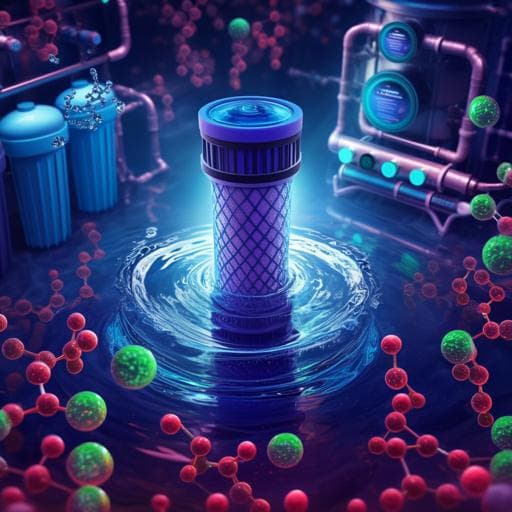
Environmental Studies and Forestry
Human exposure to per- and polyfluoroalkyl substances and other emerging contaminants in drinking water
D. Cserbik, P. E. Redondo-hasselerharm, et al.
Explore the intriguing findings from research conducted by Dora Cserbik, Paula E. Redondo-Hasselerharm, and their team, which measured various chemicals in drinking water and urine samples to assess human exposure. Their study reveals critical insights into the effectiveness of water filtration methods and highlights pressing concerns about emerging contaminants.
~3 min • Beginner • English
Introduction
The study addresses human exposure to emerging contaminants, especially per- and polyfluoroalkyl substances (PFAS), bisphenol A, and nonylphenol, via drinking water in an urban European setting (Barcelona, Spain). PFAS are persistent, mobile, and widely detected contaminants with documented adverse health associations (e.g., reduced birthweight, cancer risk, metabolic and immune effects). Legacy PFAS (PFOS, PFOA) have been phased out but persist in the environment; short-chain replacement PFAS and ether-PFAS (e.g., GenX, ADONA) are increasingly found. Evidence on PFAS in bottled water and in public supplies not directly impacted by point sources in Europe is limited. Bisphenol A and nonylphenol are endocrine disruptors with limited occurrence data in drinking water. Regulatory context includes EU Drinking Water Directive (2020/2184) thresholds for PFAS and bisphenol A, and a watch list for nonylphenol. The study’s objectives are to quantify 35 PFAS, bisphenol A, and nonylphenol in multiple drinking water types; assess human exposure via urinary PFAS; and tentatively identify additional emerging contaminants via non-target screening.
Literature Review
Background literature indicates: (1) widespread environmental occurrence and human exposure to PFAS with health concerns; (2) a trend from legacy PFAS to short-chain replacements which are more mobile and challenging to remove with conventional treatments; (3) limited European data on PFAS in bottled water and in systems away from known contaminated sites; (4) reports of background PFAS in treated water across several countries; (5) bisphenol A and nonylphenol are endocrine disruptors detected in various environmental matrices with limited data in drinking water; and (6) EU DWD 2020/2184 sets summed PFAS limits (100 ng/L for 20 PFAS, 500 ng/L for total PFAS) and a 2500 ng/L threshold for bisphenol A, while nonylphenol appears on a watch list with guidance value 300 ng/L.
Methodology
Study design and area: Barcelona’s public supply blends surface waters (Llobregat, Ter), groundwater, and desalinated water, with variable source contributions and differing raw water quality.
Sampling: Two campaigns were performed. Sampling 1 (Aug 31–Oct 16, 2020): unfiltered tap water from 42 city postal codes (homes; 3 postal codes from public fountains), filtered tap water from domestic users (N=11; 6 activated carbon, AC; 5 reverse osmosis, RO), bottled natural mineral water (10 brands; 1.5 L PET), and first-morning void urine from 39 volunteers. Sampling 2 (May 2021): repeated unfiltered tap water at the same 42 locations for seasonal PFAS variability. Participants completed questionnaires on demographics and water consumption. Ethical approval was obtained; informed consent collected.
Sample handling: Tap water collected after ~2 min flush into dedicated containers: 500 mL polypropylene (PFAS), 2.5 L glass (bisphenol A, nonylphenol), 2.5 L glass with ascorbic acid (NTS). Urine collected in sterile containers (first-morning void), refrigerated until collection. Water samples stored at 4 °C and shipped within 2 days; urine at −20 °C until analysis. Bottled waters purchased locally and transported to lab.
Target analytes: 35 PFAS (10 PFCAs C4–C13, 10 PFSAs C4–C13, 3 PFOSAs, 4 FTSs (n:2 = 4, 6, 8, 10), and 8 ether-PFAS including HFPO-DA (GenX) and ADONA); bisphenol A; nonylphenol.
Analytical methods:
- PFAS in drinking water: online SPE coupled to LC-MS/MS (TSQ Quantum triple quadrupole, ESI−, MRM). Kinetex XB-C18 column, optimized voltages/energies, argon CID, 15 min run. Measures taken to minimize background PFAS (eliminating fluoropolymer components, trapping columns, QC blanks). LOQs enhanced for PFHxA and PFOA.
- PFAS in urine: off-line SPE (Oasis-HLB) with isotope-labeled internal standards (EPA-533ES, 13C8-FOSA), sonication and centrifugation, dilution and acidification, elution with MeOH:H2O, evaporation and reconstitution, LC-MS/MS with 25 min method (flow 200 µL/min) and specified ESI parameters.
- Bisphenol A and nonylphenol: liquid–liquid extraction with dichloromethane; GC–MS/MS (EVOQ GC-TQ) per U.S. EPA Method 1625; DB-5 column; helium carrier gas; temperature program 70–310 °C; SIM mode.
Non-target screening (NTS): 2.0 L aliquots acidified (pH 2.5), extracted with Bond Elut PPL cartridges, methanol elution, LC-HRMS (UPLC with ZORBAX Eclipse XDB-C18; Q Exactive, ESI±). Full scan (m/z 70–1000, 70k FWHM) with data-dependent MS2 (17.5k FWHM, NCE 30). Data processing in Compound Discoverer 3.1: alignment (±5 ppm), peak detection, suspect screening against 248 micropollutants and metabolites (Supplementary Table 2). Confirmation based on accurate mass (±5 ppm) and MS2 spectral coherence using MassBank, FISh scoring, and MetFrag; reported as instrumental response (a.u.), confidence level per Schymanski level 2.
Statistics: Descriptive statistics on concentrations >LOQ; total/sum PFAS based on individual >LOQ values. Distribution checks via Q-Q plots and Shapiro–Wilk. Spearman correlations among chemicals detected in >45% samples (p<0.05 considered significant). Paired t-tests to assess filter removal (before/after), with variance homogeneity checks. Average percentage change calculated relative to pre-filter concentration. Analyses in R (v4.1.1).
Key Findings
Study population: 39 volunteers (60% women, 37% men, 3% non-binary), mean age 40.7 years (SD 10.2). Self-reported average daily consumption: unfiltered tap 0.6 L, bottled 0.5 L, filtered tap 0.4 L.
Tap water PFAS (unfiltered): Of 35 PFAS targeted, only PFAAs (7 PFCAs, 3 PFSAs) were >LOQ; ether-PFAS (GenX, ADONA) not detected. First sampling (N=42): total PFAS detection rate 79%, median total PFAS 30.0 ng/L (range <1–180). Most frequent detections: PFPeA 64% (median 3.3 ng/L), PFBS 64% (9.2 ng/L), PFHpA 52% (3.0 ng/L), PFHxA 31% (13.0 ng/L), PFOS 52% (12.5 ng/L). Second sampling (N=42): detection rate 69%, median total PFAS 9.8 ng/L (range <1–34); PFPeA 62% (4.0 ng/L), PFBS 45% (6.8 ng/L), PFHpA 24% (1.6 ng/L), PFOS 4.8% (11.5 ng/L in positives). Composition: first sampling dominated by PFBS (25.9%), PFOS (22.1%), PFPeA (17.6%), PFHxA (16.2%); second sampling dominated by PFPeA (45.7%) and PFBS (39.2%). Seasonal difference: median total PFAS about 3× higher in late summer/early autumn (30.0 ng/L) than in May (9.8 ng/L), consistent with documented seasonal variability in source waters.
Regulatory comparison (EU DWD 2020/2184): Sum/total PFAS identical here (only C4–C12 PFAAs detected). All samples below parametric values except one first-sampling tap water sample at 180 ng/L (exceeding 100 ng/L sum-of-20 threshold), with PFPeA 72, PFBS 52, PFOA 21, PFOS 13, PFHpA 12, PFHxA 10 ng/L.
Correlations: No statistically significant Spearman correlations (p<0.05) among frequent PFAS; moderate-to-strong positive correlations observed descriptively (e.g., PFPeA with total PFAS in S2: r=0.8).
Filters and bottled water: AC pitcher filters showed no overall improvement: median total PFAS 32.0 ng/L before vs 33.0 ng/L after (some samples increased post-filtration), suggesting limited efficacy under real-world conditions and potential breakthrough when media are loaded. RO filters reduced PFAS markedly: median 18.0 to 1.0 ng/L (−97%); three of five RO samples fell below LOQ after filtration. PFAS were not detected in bottled waters analyzed. Bisphenol A and nonylphenol were not detected in tap, filtered, or bottled waters (first sampling).
Urine PFAS: Detected in 5 of 39 samples (one PFAS each): PFPeA 0.018 ng/mL (65.9 ng/g creatinine), PFHxA 0.013 ng/mL (325 ng/g), 6:2 FTS 0.024 ng/mL (11.6 ng/g), 8:2 FTS 0.009 ng/mL (4.3 ng/g), PFOSA 0.026 ng/mL (10.8 ng/g). Some detected urinary PFAS (6:2 FTS, 8:2 FTS, PFOSA) were not present in drinking water, indicating other exposure sources; detections of PFPeA and PFHxA aligned with drinking water exposure patterns.
Non-target screening: Of 248 suspects, 16 were tentatively identified in at least one water type. Unfiltered tap water had the highest diversity (12 micropollutants, 4 metabolites). High detection frequencies in unfiltered tap water included: carbamazepine (100%), tris(chloroisopropyl) phosphate (83%), suberic acid (78%), azelaic acid (56%), and terbuthylazine (56%). AC filtering reduced detections relative to unfiltered tap but not as much as RO; personal care product acids (suberic, azelaic) appeared across all water types, including bottled. NTS identifications were at Schymanski level 2; concentrations were not quantified.
Discussion
The study provides a comprehensive snapshot of human exposure to emerging contaminants via drinking water in a large European city using combined targeted and non-targeted approaches. PFAS occurrence in Barcelona tap water was dominated by short-chain replacement PFAS (PFPeA, PFBS, PFHxA), consistent with global substitution trends and the mobility of short-chain compounds. Seasonal variability suggests source-water dynamics influence tap water PFAS levels. While most samples were below EU DWD thresholds, an exceedance underscores the need for routine monitoring and risk management. Household treatment performance varied: AC pitchers did not reliably reduce PFAS and occasionally showed higher post-filtration levels, emphasizing maintenance and potential breakthrough issues; RO provided robust removal (>90%), supporting its suitability for point-of-use mitigation. Absence of bisphenol A and nonylphenol across water types in this dataset is reassuring within the detection capabilities employed. Urinary biomonitoring detected PFAS at low frequencies and concentrations in the general population, with patterns suggesting drinking water contributes to PFPeA and PFHxA exposure, whereas other sources likely drive detections of 6:2 FTS, 8:2 FTS, and PFOSA. NTS revealed widespread occurrence of pharmaceuticals, flame retardants, pesticides, and personal care product acids in tap water, expanding the scope of potential exposures and highlighting the value of suspect screening for water quality surveillance.
Conclusion
This study quantified PFAS occurrence in Barcelona’s drinking water, demonstrated seasonal variability and dominance of short-chain PFAS, and showed that while regulatory thresholds were generally met, occasional exceedance can occur. Domestic RO filtration effectively reduced PFAS, whereas AC pitcher filters showed inconsistent performance under real-world use. Bisphenol A and nonylphenol were not detected in drinking waters analyzed. Urinary biomonitoring indicated low-level PFAS exposure among volunteers, with drinking water contributing to certain short-chain PFAS in urine. Non-target screening broadened the contaminant scope, identifying multiple pharmaceuticals, flame retardants, pesticides, and personal care product-related compounds in tap water.
Future research should include: (1) larger, longitudinal monitoring to capture seasonal and spatial variability; (2) evaluation of point-of-use filter performance over time, maintenance schedules, and different media; (3) confirmation and quantification of NTS-identified suspects using reference standards; (4) expanded biomonitoring with repeated urine or serum sampling to link water concentrations to internal dose; and (5) assessment of additional exposure sources beyond drinking water.
Limitations
Key limitations include: (1) correlation analyses limited by few compounds above LOQ and lack of statistical significance; (2) urine biomonitoring based on single spot samples rather than repeated collections; (3) small sample sizes for filtered water assessments (AC N=6; RO N=5) potentially limiting generalizability; (4) NTS results at Schymanski level 2 without confirmation by reference standards and without concentration quantification; (5) volunteer-based sampling within one city, which may limit broader representativeness; and (6) potential variability in real-world maintenance and loading of AC filters not controlled experimentally.
Related Publications
Explore these studies to deepen your understanding of the subject.







